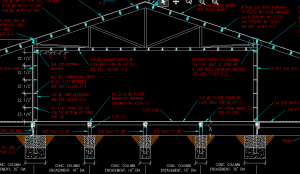DEAR POLE BARN GURU: After you dig your holes for the treated posts, do you put the post in the hole, then pour in concrete around the post or do you pour about 8” of concrete in first then let that set up and put the post on the concrete what is the best way. GARY IN FREDERICK
DEAR GARY: There is documentation to show the treated columns could be placed all of the way to the bottom of the hole and then the concrete could be poured around it (read more here: https://www.hansenpolebuildings.com/2013/04/pole-barn-post-in-concrete/).
With this said, there are some Building Officials who feel the only proper solution is to have a concrete pad poured beneath the columns. This, however, in itself will not resolve the issue of uplift. Significant research has been done in this area (see: https://www.hansenpolebuildings.com/2012/02/concrete-collars/).
We’ve found a solution which keeps Building Officials happy and resolves issues of both gravity (keeping your building from settling) and uplift is to suspend (or float) the columns in the hole and make one concrete pour which will place the premix both below and around the base of the column. Complete detail of how to do this can be found here: https://www.hansenpolebuildings.com/2015/04/floating-poles/.
DEAR POLE BARN GURU: Hi- I’m currently planning a 24×36 building with you guys on my lot in Colorado. I know I have shallow bedrock on one side so I’m going to get a soils report. With that report, can you provide detail on the post-hole design? I’ve spoken with Randy Wear and he suggested a floating slab with brackets, but didn’t sound very sure. I would think that in my area I’d need to build a whole FPSF slab which is difficult with the space requirements and budget. I’d prefer to jackhammer shallower (and maybe wider) holes into competent bedrock and then epoxy rebar into the rock and cement, then bracket the posts to that cement pad. I just need an engineer to tell me that’s going to work with the info the soils tests provided. I’m trying to avoid paying for a whole separate foundation engineering plan. Thanks for the advice. DAN IN EVERGREEN
DEAR DAN: Thank you for your investment into a new Hansen Pole Buildings kit package. Unless your Building Official requires a soils report, I wouldn’t go to the expense, as bedrock is bedrock. Personally, I’d jackhammer (or even better – a skid loader with a ram hoe attachment) the holes out in areas where the bedrock is present. In most cases, a ram hoe will chip right through the rock in a matter of hours and the issue is entirely taken care of. In the event you are unable to get to the 40 inch hole depth specified on the plans, provide us the information on the depths you are able to get to and our engineers can come up with a design for you at a minimal charge.
DEAR POLE BARN GURU: I initially ordered my building as a non-insulated building with plywood sheathing and I will be installing a composition roof.
I was recently informed that if I want to insulate the building, and not install the full flat ceiling I will want to create an air space for the underside of the roof deck. Can I supply and install a 2×4 flat perpendicular to the roof purlins prior to installing the plywood sheathing? This would allow me a 1-1/2″ air gap if I wanted to insulate between the purlins with a batt insulation and leaving me a relatively open ceiling. MATT IN WOODINVILLE
DEAR MATT: If you are going to use a product such as unfaced fiberglass batt insulation the Building Code does require airflow above the insulation and below the roof deck. Your proposed solution of running 2×4 flat perpendicular to the purlins (from eave to ridge) would work out great – except all of the trims for your building’s fascia and varge rafters are bent to fit the building as originally planned and would be 1-1/2″ short if the 2×4 were to be added. You may want to consider using closed cell spray foam insulation, as it can be applied directly to the underside of the roof sheathing and does not have to have airflow above.









